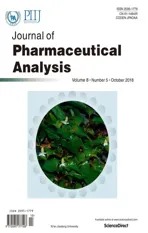JPA Prize in 2016
2018-10-18

JPA Prize Medal
The great contributor awarded the 2016 JPA Prize was as follows:
Bart De Spiegeleer
Department of Pharmaceutical Analysis
Drug Quality & Registration group
Ghent University
Belgium
The three outstanding editors awarded the 2016 JPA Prize were as follows:
1.Su Zeng
College of Pharmaceutical Sciences Zhejiang University,China
2.Yifeng Chai
School of Pharmacy The Second Military Medical University China
3.Zhiguo Yu
School of Pharmacy Shenyang Pharmaceutical University China
The three excellent referees awarded the 2016 JPA Prize were as follows:
1.Tai-Jun Hang
School of Pharmacy China Pharmaceutical University China
2.Florin Marcel Musteata
Department of Pharmaceutical Sciences Albany College of Pharmacy & Health Sciences United States of America
3.Dimitrios Tsikas
Centre of Pharmacology and Toxicology Hannover Medical School Germany
The three top cited papers awarded the 2016 JPA Prize were as follows:
1. Pei Wang, Zhiguo Yu*. Species authentication and geographical origin discrimination of herbal medicines by near infrared spectroscopy: A review. Journal of Pharmaceutical Analysis, 2015, 5(5): 277-284.

Fig. 3 Three-dimensional score plot using PC1, PC2, and PC3 for discrimination Ganoderma lucidum from three provinces,class1, Shandong Province; class2,Anhui Province; class3, Zhejiang Province.
2. Daniel J. Liput, Eleftheria Tsakalozou, Dana C.
Hammell, Kalpana S. Paudel, Kimberly Nixon, Audra L. Stinchcomb*. Quantification of anandamide,oleoylethanolamide and palmitoylethanolamide in rodent brain tissue using high performance liquid chromatography-electrospray mass spectroscopy. Journal of Pharmaceutical Analysis, 2014, 4(4): 234-241.
3. Chao-Zhan Lin, Min Hu, Ai-Zhi Wu*, Chen-Chen
Zhu*. Investigation on the differences of four flavonoids with similar structure binding to human serum albumin.Journal of Pharmaceutical Analysis, 2014, 4(6): 392-398.

Fig. 3 Interaction mode between HAS and the flavonoids (1) (A), (2)(B), (3) (C), and (4) (D), respectively. The hydrogen bonds between the four flavonoids and HAS are represented using yellow dashed line. The structures of the four flavonoids are represented using stick model, and the key residues of HAS are represented using line model.
杂志排行
Journal of Pharmaceutical Analysis的其它文章
- 3D biofabrication of vascular networks for tissue regeneration:A report on recent advances
- A rapid reporter assay for recombinant human brain natriuretic peptide(rhBNP)by GloSensor technology
- Solution pH jump during antibody and Fc-fusion protein thaw leads to increased aggregation
- Primula vulgaris extract induces cell cycle arrest and apoptosis in human cervix cancer cells
- Discoursing on Soxhlet extraction of ginseng using association analysis and scanning electron microscopy
- Molecular docking studies of human MCT8 protein with soy isoflavones in Allan-Herndon-Dudley syndrome(AHDS)
